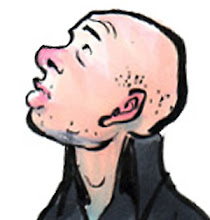I need to work on hands...

...and everything else.
Went to the Musee D'Orsay today. Went to see the current special exhibit on 19th Century Russian Art, but drew mainly from the bronzes over in the Rodin corner. I tried to be quick on each little sketch, and the quickest, loosest ones are the best. But no one will mistake it for Frazetta. I'm trying to come to grips with this new brush pen from Muji, an interesting little store that sells dour, urban clothing for men and women, bright socks made of recycled thread, and Japanese office supplies. It's just down the street from us. Bought my pad there, too, and I like it a lot--it doesn't have a lot of pages, which keeps it light, and the rear cover is stiff enough to support working hand held. More info I cannot give, for the small descriptive tag on the cover speaks only Japanese, except for the dimensions, which are 332mmx242mm, (my favorite size--thank God it's not a 293x114).
The Russian exhibit was interesting, but as I went from canvas to canvas I couldn't stop thinking of my former associates at the Atelier in Encinitas (that's San Diego country, partner), especially one Ronzelevich Lemenov. How he would love this! This man was (is?) an ardent devotée of "L'École Russe", in particular I. E. Repin, a leading light of late 19th Century painting in Russia. Repin is well represented in the show, and I kept wishing Ronzelevich were present to see Rep's work in person. What amazed me was how similar Repin's paint looked to my friend Lemenov's work--an affinity much deeper than the sort shared by Pontormo and Bronzino, for instance, or Tintoretto and Veronese. It was uncanny, and I really couldn't be sure that R. Lemenov hadn't done these--Repin even looked to be a lefty from the tilt of his script and direction of his brush strokes! The color choices, the narrow range of variation in that tightly-loose, or loosely-tight style of rendering, rigidly observed across even the most epic of scenes. A way of indicating faces, too; of moving between values on a face through toned color and surprisingly consistent texture...the complete drawing of mouths with small strokes of paint applied in accurate wedges, less conjured than in a tonalist, something almost like Rockwell but with paint twice as thick, and the same kind of magenta shift in the wet reds of a face (lips again, inner and outer canthus, nostrils) that belies the dry yellow in so much of the routine flesh. Uncanny! Also a similar size to all the short strokes of the brush, which are not at all the sort of watery dabs you get with so many painters that came after the Impressionists; nor is it like the celebrated "petite tache" of Manet, et al., (whom R. Lemenov despises)--no, they populate their work (R. Lemenov anf I. E. Repin) with small shingles of paint of almost uniform size, creating a effect completely unlike Seurat, or the linty tapestries of stabbing dabs in later Renoirs. The surface of the Lemenov/Repin canvas reads like the a floor covered in sawdust, with all sorts of arid sheafes interlocking and overlaying one another, implying uniformity and flatness, which plays off of the strongly designed shapes of the rendered imagery they create. Uncanny.
The wild-eyed portrait of Mussourgsky, familiar to me through R. Lemenov's copy, hung next to a very nice portrait of Tolstoy. Tolstoy....
My War and Peace. The first moment of pleasure at recognizing the author of this work that has so thoroughly involved me dissolved quickly. I was feeling a little uncomfortable looking at this guy. First off, I had certain ideas of what he represented as "writer", that is to say, a man who has chosen to write. These notions may or may not be apparent in a portrait, or even a photograph, and they certainly could be completely wrong-headed on my part. But I remember (perhaps an imagining) a photograph of V. Nabokov's father on a street corner engaged in a smiling and animated conversation with this little man Tolstoi; and he seemed warm and genuine, a real person. But here was something different--in the paintings, (there were two big ones, and some drawings and photos), he seemed so determinedly messianic, so "branded" as "simple visionary, peasant/priest with a pen." It all felt a bit self-conscious, a bit manufactured. I just read an article on James Patterson that interviewed him on how he invests his money. It talked about his astonishing commercial success as a writer (both he and his success were completely new to me), and much of this success he and the article attributed to his successful "branding." Was this what Tolstoy was up to? Put this against a riveting photo of a really young looking Chekov sitting at a table next to Gorky--it feels honest, unselfconscious, and at the same time worth recording. You look at these guys and it strikes you immediately, before you even know who they are: you say, "There is something going on in those minds." Their thoughtful and observant lives are there to see plainly. Tolstoy seemed a little contrived, repeating poses in photos and portrait paintings, standing with his hand in his belt, wearing a peasant's tunic, self-consciously standing on the land, in nature, book in pocket, posed.


0 Comments:
Enregistrer un commentaire
<< Home